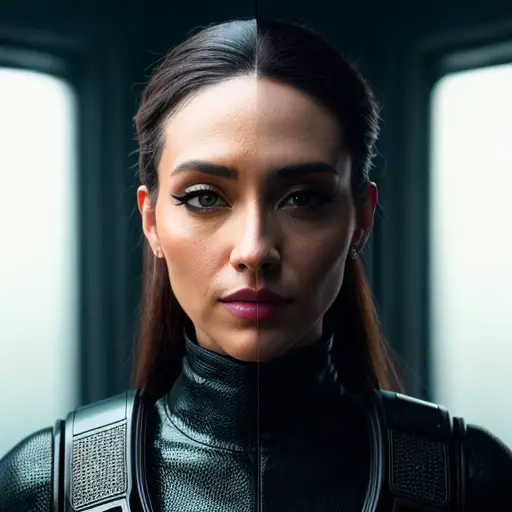Picture this: a serene beach scene, complete with palm trees swaying gently in the breeze, crystal-clear turquoise waters, and a lone sunbather soaking up the rays. Now, imagine right beside it, a bustling cityscape with towering skyscrapers, honking taxis, and a sea of people rushing about. This, my friends, is the art of juxtaposition in photography. It's all about capturing the power of contrasts, the unexpected pairings that make us do a double-take and question our perception of reality. It's like witnessing a harmonious dance between two completely different worlds, where the beach and the city collide in a visual symphony that leaves us both bewildered and captivated. So, grab your camera and let's dive into the enchanting world of juxtaposition, where the ordinary becomes extraordinary, and the mundane transforms into magic.
Juxtaposition in photography is the art of placing two or more contrasting elements side by side within a single frame, creating a visually striking and thought-provoking composition. It allows photographers to highlight the differences between subjects, objects, or concepts, often resulting in a deeper narrative or emotional impact. Juxtaposition can be achieved through various means, such as contrasting colors, sizes, shapes, textures, or even by combining unexpected elements. This technique not only adds intrigue and complexity to photographs but also encourages viewers to question and interpret the relationships between the juxtaposed elements, leading to a more engaging and memorable visual experience.
Imagine a photograph that showcases a dilapidated, abandoned building, its crumbling walls a testament to the passage of time. Now, juxtapose it with a vibrant, blooming flower garden right in front of it, bursting with life and color. This, my fellow photography enthusiasts, is the beauty of juxtaposition. It's about using contrasts to tell a story, to evoke emotions, and to challenge our preconceived notions. Juxtaposition in photography is like a secret language, allowing us to create visual poetry by combining elements that seem worlds apart. It's a creative tool that pushes us to think outside the box, to see the extraordinary in the ordinary, and to capture moments that make us pause and ponder. So, grab your camera and let's embark on a journey beyond the lens, where juxtaposition becomes a gateway to endless possibilities.

Visual storytelling is an art form that allows photographers to weave narratives through their images, capturing moments that speak volumes without uttering a single word. And at the heart of this storytelling lies the power of juxtaposition. Juxtaposition in photography is the art of placing contrasting elements side by side, creating a dynamic tension that engages the viewer and unveils the deeper meaning behind the image.
In photographic narratives, juxtaposition serves as a powerful tool to convey emotions, ideas, and concepts. It can be as simple as contrasting light and shadow, or as complex as juxtaposing different subjects to create a thought-provoking dialogue. By juxtaposing elements, photographers can create visual metaphors, highlighting the stark differences or unexpected similarities between two seemingly unrelated subjects. This technique adds depth and layers to the narrative, inviting viewers to interpret the image and connect with the story on a personal level.
Juxtaposition also allows photographers to challenge conventional perspectives and question societal norms. By placing contrasting elements together, photographers can shed light on social issues, cultural differences, or even personal struggles. It encourages viewers to step out of their comfort zones and see the world through a different lens, fostering empathy and understanding.
Furthermore, juxtaposition in photographic narratives can create a sense of irony or humor. By combining elements that are inherently contradictory or unexpected, photographers can elicit a range of emotions from their audience. It adds a touch of surprise and intrigue, making the viewer pause and reflect on the underlying message or story being told.
In essence, juxtaposition in photography is a powerful storytelling technique that goes beyond capturing a single moment. It allows photographers to create visual narratives that provoke thought, evoke emotions, and challenge perceptions. Through the artful placement of contrasting elements, photographers can unveil the impact of juxtaposition in their photographic narratives, leaving a lasting impression on the viewer's mind.
Fun fact: Juxtaposition in photography is like a visual magic trick! It involves placing two or more contrasting elements side by side in a photograph, creating a captivating and often humorous effect. It's like blending two different worlds together, making us see things in a whole new light. So, next time you spot a photo with unexpected combinations, remember that it's the power of juxtaposition at play, adding a touch of whimsy and surprise to the art of photography!
In the world of photography, juxtaposition is the secret ingredient that transforms ordinary scenes into extraordinary works of art. It's like adding a pinch of magic to a seemingly mundane composition, instantly elevating its aesthetic appeal. Juxtaposition in photography is all about finding the unexpected, the contrasting elements that create visual tension and intrigue. It's about capturing that perfect moment when two seemingly unrelated subjects come together in a harmonious dance, creating a captivating image that sparks curiosity and leaves a lasting impression. Whether it's contrasting colors, textures, or even emotions, juxtaposition adds that extra layer of visual interest, turning a simple photograph into a masterpiece that demands attention. So, next time you're behind the lens, don't be afraid to seek out those unexpected pairings and let juxtaposition work its enchanting magic.